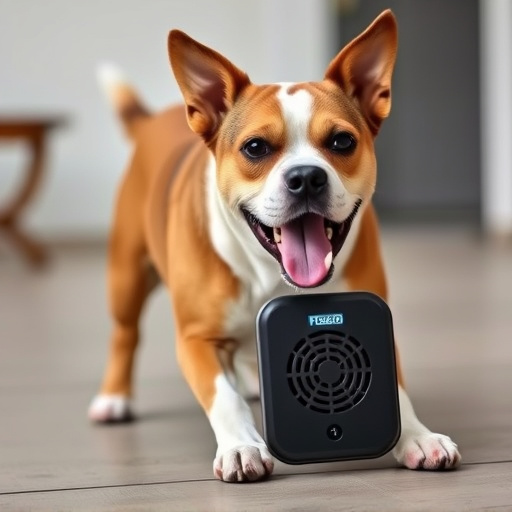Dog repellent devices protect property from unwanted canine visitors, with options like ultrasonic emitters and motion-activated sprinklers. For best results, choose a device matching your property size, consider advanced technology, app connectivity, and adjust placement strategically for continuous protection. Balancing safety, legality, and ethics is crucial when using these devices, which offer security but may have regional restrictions and potential animal harm concerns.
“Personal security dog deterrent devices are innovative tools designed to enhance outdoor safety. These devices utilize various technologies to repel and deter dogs, offering a peaceful solution for homeowners concerned about unwanted animal intrusions. In this comprehensive guide, we’ll explore the inner workings of dog repellent devices, uncover essential features to look for, and navigate key considerations for optimal outdoor coverage. From range and activation areas to legalities and ethical debates, get ready to secure your space effectively.”
- Understanding Dog Repellent Devices: How They Work and Their Effectiveness
- Key Features to Consider When Choosing a Personal Security Dog Deterrent Device
- Evaluating Outdoor Coverage: Range, Activation Area, and Placement Strategies
- Safety, Legalities, and Ethical Considerations for Using Dog Repellent Devices Outdoors
Understanding Dog Repellent Devices: How They Work and Their Effectiveness
Dog repellent devices are designed to protect your property by deterring unwanted animals, particularly dogs, from entering specific areas. These devices work using a combination of sensory triggers and effective chemicals. Ultrasonic devices emit high-frequency sound waves that are inaudible to humans but can startle and repel dogs. Motion-activated sprinklers use water as a deterrent, spraying when motion is detected, often targeting the dog’s sensitive eyes and skin.
The effectiveness of these devices varies based on factors like outdoor coverage area, environmental conditions, and the size and behavior of the target animals. For best results, choose a device suitable for your property size, ensuring it covers all entry points. Regular testing and maintenance are crucial to ensure continuous protection. Some users report success with these deterrents, while others may find them less effective due to individual dog training and regional wildlife habits.
Key Features to Consider When Choosing a Personal Security Dog Deterrent Device
When choosing a personal security dog deterrent device, several key features should be at the top of your list to ensure maximum effectiveness and peace of mind. First and foremost, consider the outdoor coverage area the device can protect. Different models offer varying ranges, so select one that suits the size of your property for optimal protection. Additionally, look for devices with adjustable settings to cater to different scenarios; whether you need a constant, high-intensity deterrent or a more subtle, motion-activated response.
The dog repellent capabilities of these devices are another critical aspect. Advanced technology often employs ultrasonic sounds or safe, non-toxic sprays to deter dogs without causing them harm. Some models even include app connectivity for remote control and monitoring, allowing you to adjust settings from anywhere. Ensure the device is reliable, easy to maintain, and backed by a reputable manufacturer’s warranty for long-term use.
Evaluating Outdoor Coverage: Range, Activation Area, and Placement Strategies
When evaluating a dog repellent device for outdoor usage, understanding its coverage is paramount. The range of these devices varies significantly, with some offering spot protection while others can cover expansive areas. Ideally, select a dog repellent device that can effectively encompass your desired activation area, whether it’s your backyard, garden, or even a larger property perimeter.
Placement strategies are equally critical. For optimal results, position the device strategically to deter dogs from entering specific zones. This could involve placing them along fences, at entry points, or in areas known for dog activity. Regularly review and adjust placement based on changing patterns and needs to ensure continuous protection.
Safety, Legalities, and Ethical Considerations for Using Dog Repellent Devices Outdoors
When considering a dog repellent device for outdoor use, it’s paramount to balance safety, legalities, and ethical considerations. These devices, designed to deter dogs from entering specific areas, offer a perceived sense of security for homeowners, especially in regions with strict leash laws or problematic stray dog populations. However, their usage isn’t without potential pitfalls.
Legally, the use of dog repellent devices varies by jurisdiction. Some areas have strict regulations on the type and intensity of repellents allowed, while others may have no specific rules. It’s crucial to research local ordinances before deployment to avoid fines or legal repercussions. Moreover, ethical debates surround their effectiveness and potential harm to animals. While some dogs may be deterred, others could be startled or even harmed by the scent or sound triggers. Responsible use demands a thorough understanding of these devices’ limitations and a commitment to minimizing any adverse effects on wildlife and neighbors’ pets.
Personal security dog deterrent devices offer a unique solution for outdoor spaces, providing peace of mind with their advanced technology. By understanding how these devices work and considering essential features, users can make informed choices to protect their areas effectively. When selecting a device, evaluating outdoor coverage is crucial, ensuring the right range, activation area, and strategic placement. Additionally, it’s vital to stay informed about legalities and ethical considerations to use these tools responsibly and maintain a safe environment for all.
